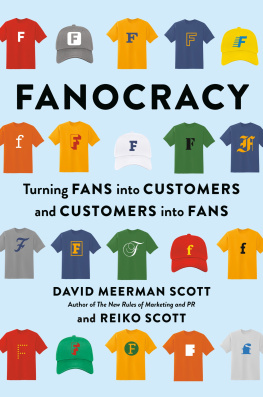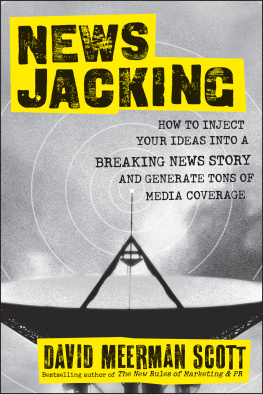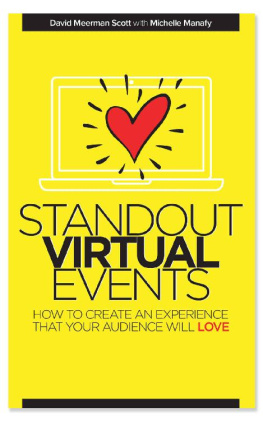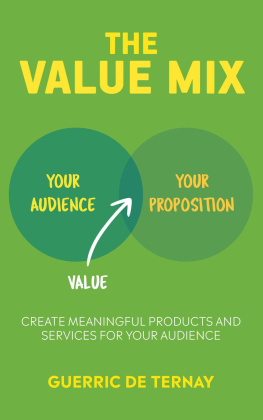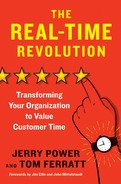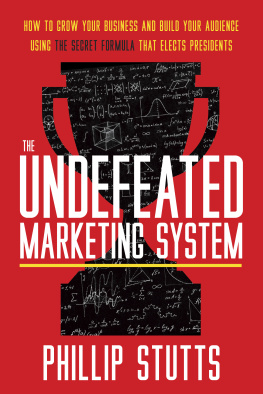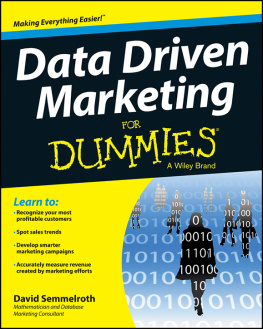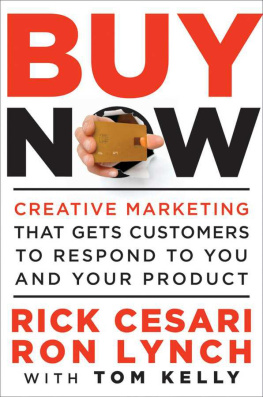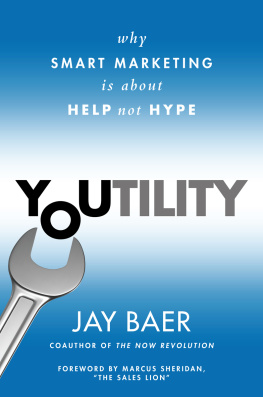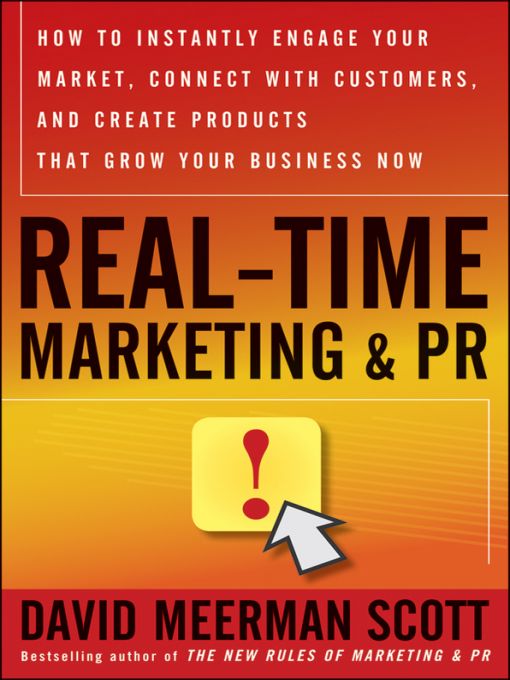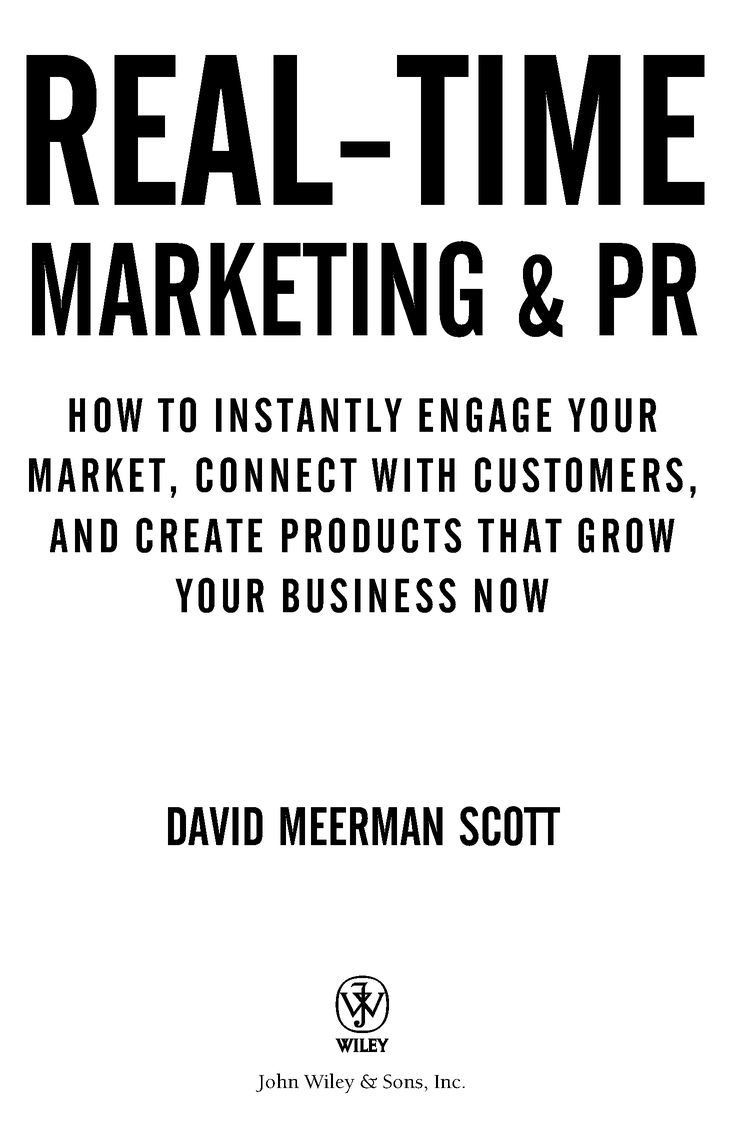Table of Contents
Praise for Real-Time Marketing & PR
With his acute ear for the cash register and his journalists sense of urgency, no one understands the value of time better than David Meerman Scott. He teaches marketers and C-level execs how to use time and urgency to gain huge competitive advantage. Read Real-Time Marketing & PR. Make money while your competitors sleep.
Brian Fetherstonhaugh
Chairman & CEO, OgilvyOne Worldwide
If you are not hooked (hook, line, and sinker) within 10 minutes of starting David Meerman Scotts wonderful new book, well, I fear for you. Beautifully written, cases that reach out from the page and grab you and shake you, and practical advice that anyone, anywhere can use in a flash to make hay. I simply loved this book, and doubled my knowledge along the way.
Tom Peters
Author of The Little Big Things
Information is like running water. The speed of information as it cascades through digital channels has been dramatically accelerated and amplified requiring marketing to change in order to catch up to this new reality. Real-Time is the keyword.
Hiroshi Ishii
Muriel R. Cooper Professor of Media Arts and Sciences,
Massachusetts Institute of Technology,
and Associate Director of MIT Media Laboratory
Right now, opportunities are passing you by as prospective customers and journalists search and chat online for solutions to their problems. Davids new book, Real-Time Marketing & PR, gives you the playbook and toolbox to help you act fast and be present as these conversations emerge. However, the real message of the book is one of mind-set: How can you deliver value faster today? Entrepreneurs and intrapreneurs focused on growing their profits, customers, and influence now cant afford to wait to read this book.
Richard Jackson
Chairman & CEO, Jackson Healthcare
We all know that opportunities and threats from the digital world often arrive without warning. They cant wait for discussion at monthly planning meetings. Hell, most times they cant wait for you to finish lunch! David Meerman Scotts book provides a rationale to help you create real-time mind-set in your own organization.
Bill Sledzik, Associate Professor
School of Journalism & Mass Communication, Kent State University
The world has changed dramatically, and we have now entered a new, real-time era. Dusty business plans are now being crushed by right-now strategy and adaptation. Davids book offers the new road map to entrepreneurs, business leaders, and individuals. Its made a big impact on the way I approach our business and our customers; the insight Ive gained by reading it is priceless. This important and thoughtful book is a must-read to compete in the next era of business, and life.
Josh Linkner
Chairman/Founder, ePrize
and author of Disciplined Dreaming:
A Proven System to Unleash Business Creativity
Also by David Meerman Scott
The New Rules of Marketing and PR (Second Edition): How to Use Social Media, Blogs, News Releases, Online Video, and Viral Marketing to Reach Buyers Directly
Marketing Lessons from the Grateful Dead: What Every Business Can Learn from the Most Iconic Band in History (with Brian Halligan)
World Wide Rave: Creating Triggers that Get Millions of People to Spread Your Ideas and Share Your Stories
Tuned In: Uncover the Extraordinary Opportunities that Lead to Business Breakthroughs (with Craig Stull and Phil Myers)
Cashing in with Content: How Innovative Marketers Use Digital Information to Turn Browsers into Buyers
Eyeball Wars: A Novel of Dot-Com Intrigue
Prologue
A wareness of information as it happens, in real time, can give you an enormous competitive advantageif you know how to use it. This was a key lesson I learned working on Wall Street in the go-go 1980s.
Its 1985, and Im on the institutional trading floor of an investment bank in lower Manhattan. Its nearly noon, time for lunch, and nothing has happened all morning. But none of the bond traders leaves. Theyre scared they might miss something. The bank doesnt want them leaving either, so everyone gets pizza delivered to their desks.
Inhabiting a world of split-second decisions, bond traders earn big money making trades involving hundreds of millions of dollars. Its a daily battle that involves incredibly long periods of tedium punctuated by occasional short bursts of intense action.
Fortunes are made in seconds; reputations lost in a minute.
Nothing is happening now, though. All is quiet, and boredom reigns because no significant news has broken all morning.
Some traders desperately search their real-time news feeds from Dow Jones, Reuters, and the Associated Press for an angle, any angle, in the quiet market. Whats Ronald Reagan up to today? What about Margaret Thatcher? Any news from Paul Volcker, the Federal Reserve chairman? Any economic data due to be released this afternoon? Any large companies announcing quarterly earnings today?
As they pore through data and news, the traders are poised, ready to commit huge sums of money when the moment is right. They peer intently at the Bloomberg screens displaying bond prices the moment they change. Data from futures markets and stock exchanges update the instant a trade is made.
Speed on the trading floor is so crucial that traders are linked one to one with their counterparts at other institutions by direct, dedicated linesjust like the Kremlin and the White House.
At a nearby desk, I see a phone panel light up (no ringing on the trading floor), and a trader answers by jabbing the button with his middle finger. But when he sits back relaxed, his body language tells me hes simply swapping the latest off-color joke or talking football.
Suddenly, one of the senior traders yells, loud as he can: The Feds in!
For a split second, the room is completely silent as all listen.
When the senior trader then bellows Buying treasuries! its as if a bomb has hit. The entire room erupts in highly organized chaos. Pizza is tossed aside, and phones are grabbed in one fluid movement. Its time to earn those huge salaries.
In a heartbeat, everyone is on at least one phone, and many are on two or more, alerting customers in an instant: The Fed is in!
Within seconds, the screens light up in seas of green as bond prices rise steeply across the board. Before the same minute expires, financial newswires like Dow Jones and Reuters write and issue newsflashes that appear instantly on trading room screens from Albuquerque to Zagreb. Within just 60 seconds, everywhere knows and everyone is equal again. The competitive advantage disappears.
But within that minute the traders who got their orders placed a split-second faster had earned their daily bread. Being first with the news is valuable currency that earns them lucrative deals from their clients. Hearing it first and acting on it fast equals moneylots of moneyon Wall Street.
Since I first witnessed a Wall Street minute in 1985, trading technology has advanced light-years. But what I saw then was still new: Technology was transforming financial trading into a game where instant information informs split-second decisions worth millions of dollars.
Its impossible to overstate the impact of innovations in computing and telecommunications on the financial markets in the 1980s. Within a decade finance was transformed from a clubby, old-boys network to a 24-hour global trading system. With that revolutionary shift a new currency of success emerged: the ability to gather, interpret, and react to new information in fractions of a secondreal time.


